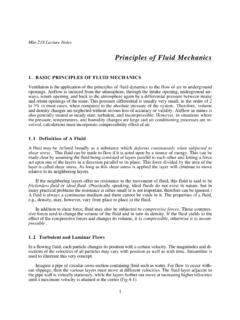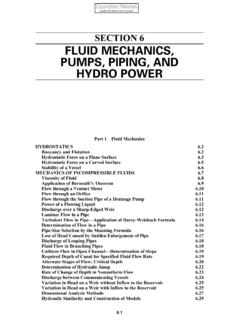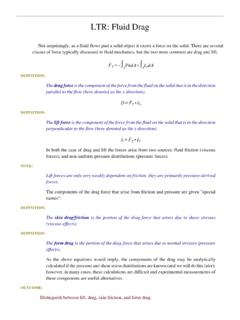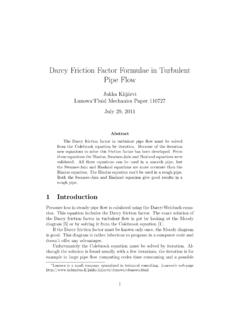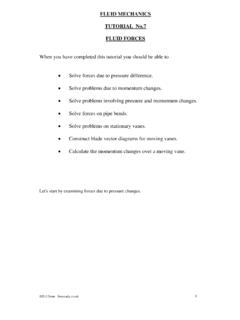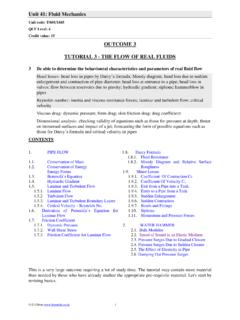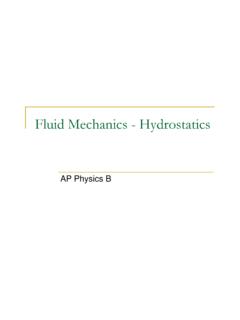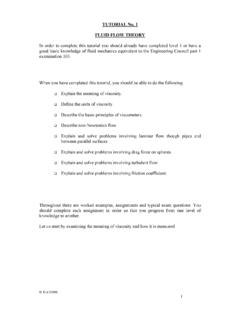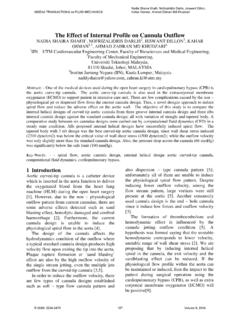Transcription of A Physical Introduction to Fluid Mechanics - Fluid …
1 A Physical Introduction to Fluid Mechanics Study Guide and Practice Problems Spring 2018. A Physical Introduction to Fluid Mechanics Study Guide and Practice Problems Spring 2018. by Alexander J. Smits Professor of Mechanical and Aerospace Engineering Princeton University February 1, 2018. Copyright Smits c 2018. Contents 1 Introduction 1. Study Guide .. 1. Worked Examples .. 1. Problems .. 9. 2 Fluid Statics 13. Study Guide .. 13. Worked Examples .. 14. Problems .. 22. 3 Equations of Motion in Integral Form 47. Study Guide .. 47. Worked Examples .. 47. Problems .. 60. 4 Kinematics and Bernoulli's Equation 81. Study Guide .. 81. Worked Examples .. 81. Problems .. 84. 5 Differential Equations of Motion 99. Study Guide .. 99. Worked Examples .. 99. Problems .. 104. 6 Irrotational, Incompressible Flows 111.
2 Study Guide .. 111. Worked Examples .. 111. Problems .. 113. 7 Dimensional Analysis 117. Study Guide .. 117. Worked Examples .. 117. Problems .. 122. 8 Viscous Internal Flows 133. Study Guide .. 133. Worked Examples .. 133. Problems .. 139. v vi CONTENTS. 9 Viscous External Flows 151. Study Guide .. 151. Worked Examples .. 152. Problems .. 154. 10 Open Channel Flow 163. Study Guide .. 163. Worked Examples .. 164. Problems .. 167. 11 Compressible Flow 185. Study Guide .. 185. Worked Examples .. 185. Problems .. 190. 12 Turbomachines 193. Worked Examples .. 193. Problems .. 197. 13 Environmental Fluid Mechanics 201. Problems .. 201. Answers to Selected Problems 203. Chapter 1. Introduction Study Guide A Fluid is defined as a material that deforms continuously and permanently under the application of a shearing stress.
3 The pressure at a point in a Fluid is independent of the orientation of the surface passing through the point; the pressure is isotropic. The force due to a pressure p acting on one side of a small element of surface dA. defined by a unit normal vector n is given by pndA. Pressure is transmitted through a Fluid at the speed of sound. The units we use depend on whatever system we have chosen, and they include quan- tities like feet, seconds, newtons and pascals. In contrast, a dimension is a more abstract notion, and it is the term used to describe concepts such as mass, length and time. The specific gravity (SG) of a solid or liquid is the ratio of its density to that of water at the same temperature. A Newtonian Fluid is one where the viscous stress is proportional to the rate of strain (velocity gradient).
4 The constant of proportionality is the viscosity, , which is a property of the Fluid , and depends on temperature. At the boundary between a solid and a Fluid , the Fluid and solid velocities are equal;. this is called the no-slip condition. As a consequence, for large Reynolds numbers (>> 1), boundary layers form close to the solid boundary. In the boundary layer, large velocity gradients are found, and so viscous effects are important. At the interface between two fluids, surface tension may become important. Surface tension leads to the formation of a meniscus, drops and bubbles, and the capillary rise observed in small tubes, because surface tension can resist pressure differences across the interface. Worked Examples Example : Units, and converting between units Consider a rectangular block with dimensions 300 mm 100 mm 25 mm, of mass 10 kg, resting on a surface (Figure ).
5 The pressure acting over the area of contact can be found 1. 2 CHAPTER 1. Introduction . as follows. Solution: Since pressure is a stress, it has dimensions of force per unit area. When in position (a), the force exerted on the table is equal to the weight of the block (= mass . gravitational acceleration = 98 N ), and the average pressure over the surface in contact with the table is given by 98. N/m2 = 39, 200 P a 100 25 10 6. In position (b), the force exerted on the table is still equal to 98. N , but the average pres- sure over the surface in contact with the table is reduced to 98 300 25 10 6 N/m2 , that is, 13, 067 P a. We can repeat this example using engineering units. Let's take a rectangular block, made of a different material with dimensions 12 in. 4 in. 1 in., of mass 20 lbm (this is similar to the case shown in Figure ).
6 Find the pressure acting over the area in the BG. system. Solution: The unit lbm is not part of the engineering system of units (see Table ), so we first convert it to slugs, where mass in lbm 20. mass in slugs = = slug = slug So 20 lbm = slug. When in position (a), the force exerted on the table is equal to the weight of the block (= mass gravitational acceleration = 20 lbf ), and the average pressure over the surface in contact with the table is 20/(4 1) lbf , that is, 5 psi. In position (b), the force exerted on the table is still equal to 20 lbf , but now the average pressure over the surface in contact with the table is 20/(12 1) lbf , that is, psi. Example : Hydraulic presses and hoists A hydraulic press uses the transmissibility of Fluid pressure to produce large forces. A. simple press consists of two connected cylinders of significantly different size, each fitted with a piston and filled with either oil or water (see Figure ).
7 The pressures produced by hydraulic devices are typically hundreds or thousands of psi, so that the weight of the Fluid can usually be neglected. If there is an unobstructed passage connecting the two cylinders, then p1 p2 . Since pressure = (magnitude of force)/area, F f A. = , so that F = f A a a Figure : Pressure exerted by a weight resting on a surface. All dimensions in millimeters. WORKED EXAMPLES 3. Figure : Hydraulic press. Figure : Hydraulic drum brake system. The pressure transmission amplifies the applied force; a hydraulic press is simply a hydraulic lever. A hydraulic hoist is basically a hydraulic press that is turned around. In a typical garage hoist, compressed air is used (instead of an actuating piston) to force oil through the connecting pipe into the cylinder under a large piston, which supports the car.
8 A lock-valve is usually placed in the connecting pipe, and when the hoist is at the right height the valve is closed, holding the pressure under the cylinder and maintaining the hoist at a constant height. A similar application of the transmissibility of pressure is used in hydraulic brake systems. Here, the force is applied by a foot pedal, increasing the pressure in a master cylinder, which in turn transmits the pressure to each brake or slave cylinder (Figure ). A brake cylinder has two opposing pistons, so that when the pressure inside the cylinder rises the two pistons move in opposite directions. In a drum brake system, each brake shoe is pivoted at one end, and attached to one of the pistons of the slave cylinder at the other end. As the piston moves out, it forces the brake shoe into contact with the brake drum.
9 Similarly, in a disk brake system, there are two brake pads, one on each side of the disk, and the brake cylinder pushes the two brake pads into contact with the disk. Example : Finding the pressure in a Fluid Consider the piston and cylinder illustrated in Figure If the piston had a mass m = 1 kg, and an area A = m2 , what is the pressure p of the gas in the cylinder? Atmospheric pressure pa acts on the outside of the container. 4 CHAPTER 1. Introduction . Solution: The piston is not moving so that it is in equilibrium under the force due to its own weight, the force due to the gas pressure inside of the piston (acting up), and the force due to air pressure on the outside of the piston (acting down). The weight of the piston = mg, where g is the acceleration due to gravity ( m/s2 , or f t/s2 ).
10 The force due to pressure = pressure area of piston. Therefore pA pa A = mg = 1 kg m2 /s = N. That is, N. p pa = = 980 P a m2. where P a = pascal = N/m2 . What is this excess pressure in psi (pounds per square inch)? A standard atmosphere has a pressure of lbf , or 101, 325 P a (see Table ). Therefore, 980 P a is equal to 980/101325 psi = psi. Example : Force due to pressure In the center of a hurricane, the pressure can be very low. Find the force acting on the wall of a house, measuring 10 f t by 20 f t, when the pressure inside the house is in of mercury, and the pressure outside is in. of mercury. Express the answer in lbf and N . Solution: A mercury barometer measures the local atmospheric pressure. A standard atmosphere has a pressure of lbf , or 101, 325 P a or N/m2 Table ). When a mercury barometer measures a standard atmosphere, it shows a reading of 760 mm or in.
